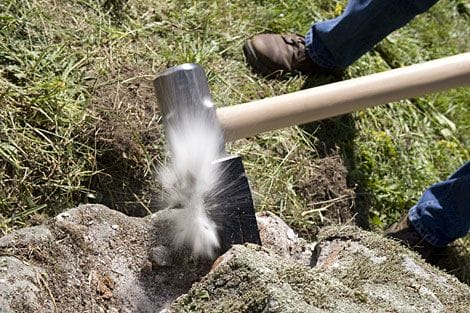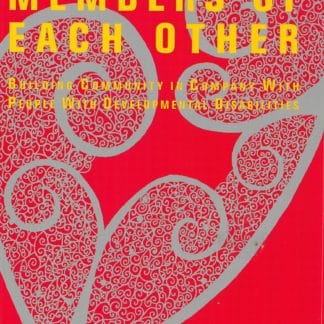
by John O’Brien
Metaphors shape options for action by influencing thought. Imagine a person with a disability as suffering from a disease, channel attention into the search for a cure and compliance with treatment regimes. Imagine a system as a machine, channel attention toward engineering mechanisms of command and control.
Playing with metaphors can sharpen awareness of the mental models that mold our strategies. Recent conversations have referred to cracks as an element in meaningful change. Each conversation brought a different image to mind.
The idea of a crack as a space that nourishes a better future plays a part in framing strategies for change in systems that seem impervious. The different images point to different possibilities to read a situation and take action. In each of the four ways noted here it is worth searching for the cracks in a daunting environment.

A place to drive a wedge
The system is a boulder that obstructs our purposes. Disruption makes weak spots visible. A sturdy wedge in a crack multiplies hammer force and splits rock. Oppressive, obstructive structures break open and fall away. Ground to rebuild opens. If the hammer is heavy enough and those who wield it have stamina enough, resistance is crushed and big change follows.
Alternatively, imagine the system as an oppressive bureaucracy capable of maintaining social exclusion because it freezes its functionaries into ignorance, blame, and fear. In this environment, change makers become the wedge, seeking opportunities to bring their open minds, open hearts, and open wills into relationships that transform the social field. Exercising soul force in an environment with few life signs demands as much stamina as breaking rocks.

Space for a plant to grow
In its early manifestations the Beloved Community develops organically as passion for life generates multiple and varied expressions of just and creative relationships. These become possible because social surfaces that appear impenetrable are riddled with microscopically tiny cracks. When a tiny seed finds just what they need to germinate, root tips work, molecule by molecule, to follow and widen microscopic paths of least resistance. Thickening roots widen cracks. Microbes digest stone. Water seeps in to erode and undermine inhospitable surfaces. With time enough, as numbers and types of plants increase, a more diverse and alive ecosystem emerges.
Facilitating change involves seeing and nurturing seeds: people who want more of life enough to risk breaking open to sense possible pathways and co-create ways to grow into them.
Reverse perspective and imagine the change maker as a seed. The machinery of social exclusion is programmed to mindlessly bury us in a gray avalanche of fear provoking, life draining, compliance worshiping busyness. A good seed discerns and serves the pattern of life enfolded in its DNA. It makes a way out of no way by seeking space and nutrients to grow into its form and extending its roots to communicate and exchange with other growing organisms around it. It will play its part in evolving an ecosystem that promotes flourishing.

A way to keep on
There is a crack in everything That’s how the light gets in.
The lyric that includes these lines piles up images to impress change makers with the limits of their efforts and nonetheless to praise a way of resistance. Wars will be fought again, the holy dove will be caught again, governmental sterility and impotence will thwart our efforts again and again. And yet change makers can confidently join in an anthem. Darkness is a tangible force and many calls to community have been silenced. But there are always cracks that allow light in and push back the darkness. There are always bells that can still ring. By attending to the present, stepping away from the crowd that downloads oppression, finding voice, and accepting the insecurity of refugee status, hearts will come to love. Perfect plans and errorless performance are beyond our reach, but thankfully imperfect offerings will let light contest with darkness.
A contrasting metaphor
by Hanns Meissner

In the eye of the hurricane the sky is blue and birds can fly there without suffering harm.The eye of the hurricane is in the very middle of destructive power, and that power is always near, surrounding that blue beauty and threatening to invade it…In a world of moral hurricanes some people can and do carve out rather large ethical spaces. In a natural world and a social world swirling in cruelty and love, we can make room. We who are not pure ethical beings can push away the choking circle of brute force that is around and within us. We may not be able to push it far away, but when we have made as much room as we can, we may know a blue peace that the storm does not know.
–Philip Hallie
I am struck how different the metaphors of “cracks” are from “blue space”. Blue space is found within and among dynamic forces. The blue is a space within these turbulent forces and has a relationship with them. Blue space is facilitated and relational. It is also found within ourselves, as we create intention and internal conditions to connect with others in positive actions.
To me, cracks are found in rigid and calcified physical environments. They are external to us, they are both physical and social constructions. They appear when structures begin to deteriorate and lose their integrity. They also show as the life that emerges after destructive acts (Chernobyl) or natural disaster (Mt Saint Helens). The cracks and the life-forces are examples of resilience. To enlarge cracks often takes force, yet there are circumstances were something emerges in spite of unfriendly conditions.
This is a value of metaphor, it allows for different perspectives to enlighten our experience.



